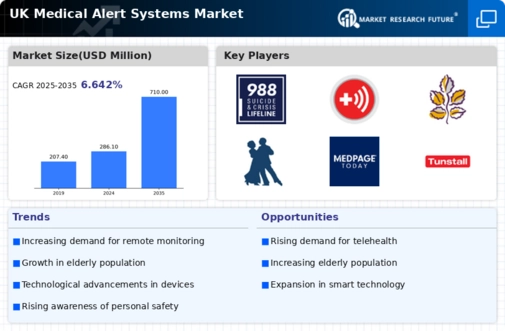Aging Population Demographics
The aging population in the UK is a primary driver for the medical alert-systems market. As the demographic shifts, with individuals aged 65 and over projected to reach 23% of the total population by 2030, the demand for medical alert systems is likely to increase. This demographic is particularly vulnerable to health issues, necessitating immediate access to emergency services. The medical alert-systems market is responding to this need by offering devices that are user-friendly and tailored to elderly individuals. Furthermore, the rise in chronic health conditions among older adults further emphasizes the necessity for these systems, as they provide peace of mind for both users and their families. Consequently, the market is expected to see substantial growth, potentially exceeding £1 billion by 2027.
Government Support and Regulations
Government support and regulations are pivotal in shaping the medical alert-systems market. The UK government has implemented various initiatives aimed at improving healthcare access and safety for the elderly and disabled populations. Funding programs and subsidies for assistive technologies are encouraging the adoption of medical alert systems. Furthermore, regulatory frameworks ensure that these devices meet safety and efficacy standards, fostering consumer trust. As the government continues to prioritize health and safety, the medical alert-systems market is expected to expand, with potential funding reaching £200 million by 2026. This support not only enhances market growth but also encourages innovation within the industry.
Rising Incidence of Chronic Diseases
The rising incidence of chronic diseases in the UK is a significant driver for the medical alert-systems market. Conditions such as heart disease, diabetes, and respiratory illnesses are becoming increasingly prevalent, necessitating constant monitoring and quick access to medical assistance. As the population ages and lifestyle-related health issues become more common, the demand for medical alert systems is likely to surge. These systems provide essential support for individuals managing chronic conditions, allowing for timely interventions in emergencies. The medical alert-systems market is projected to grow substantially, with estimates suggesting an increase in market size by 20% over the next five years, driven by the need for reliable health monitoring solutions.
Technological Advancements in Devices
Technological advancements play a crucial role in shaping the medical alert-systems market. Innovations such as wearable technology, mobile applications, and smart home integration are enhancing the functionality of these systems. For instance, the incorporation of GPS tracking and fall detection features has made devices more reliable and appealing to consumers. The market is witnessing a shift towards more sophisticated systems that not only alert users but also provide real-time health monitoring. This evolution is likely to attract a broader customer base, including younger individuals who may require assistance due to various health conditions. As a result, The medical alert-systems market is projected to grow at a CAGR of approximately 5.92% over the next five years, reflecting the increasing adoption of advanced technologies.
Increased Awareness of Health and Safety
There is a growing awareness of health and safety among the UK population, which significantly impacts the medical alert-systems market. Public health campaigns and educational initiatives have highlighted the importance of having emergency response systems in place, particularly for vulnerable groups. This heightened awareness is leading to an increase in consumer demand for medical alert systems, as individuals seek to ensure their safety and well-being. Additionally, the rise in health-related concerns, such as heart disease and diabetes, has prompted families to invest in these systems for their loved ones. The medical alert-systems market is likely to benefit from this trend, with an estimated increase in sales by 15% over the next few years as more consumers recognize the value of these devices.

















Leave a Comment